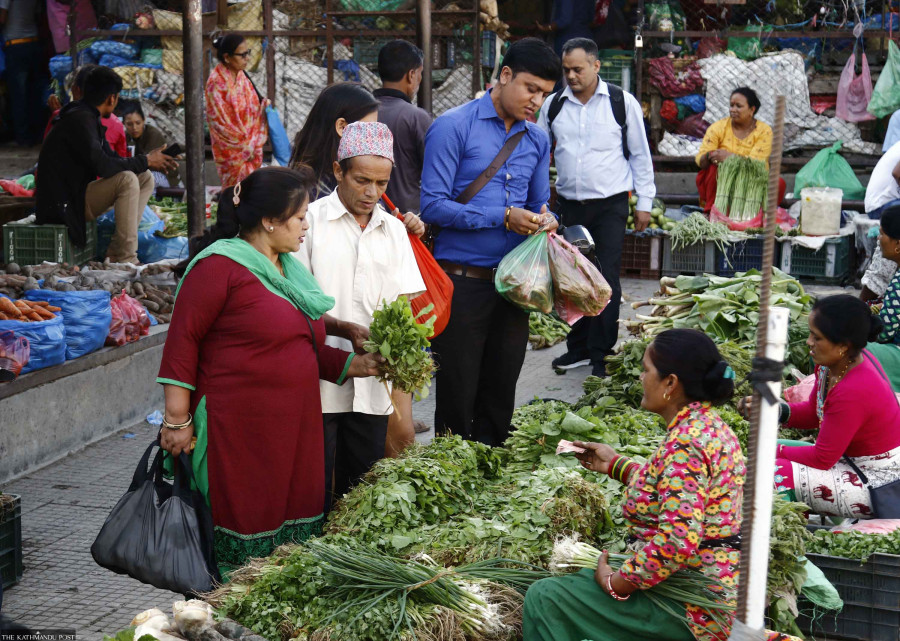Money
Nepal’s inflation hit 74-month high in September
Price rises in the month more than doubled to 8.64 percent from 3.49 percent in the same month last year, according to Nepal Rastra Bank.
Krishana Prasain
Nepal’s inflation unexpectedly surged to an 74-month high last month, raising concerns that market prices may climb further with election spending nearing fever pitch.
Price rises in September more than doubled to 8.64 percent from 3.49 percent in the same month last year, according to Nepal Rastra Bank.
The last time Nepal faced such runaway inflation was in 2015-16 when India imposed a trade blockade causing acute shortages of essential goods. The price of petrol had jumped from Rs104 to an unbelievable Rs500 per litre.
During that time, monthly inflation hit a high of 12.06 percent in January 2016.
Analysts say the country could see similar wild price rises this year as the government has not been serious about controlling inflation.
“Double-digit inflation is looming, and it may come as early as 2023,” said economist Keshav Acharya. “The November election will definitely fuel inflation.”
Economists have warned that massive campaign spending by political parties during the general elections slated for November 20 could push up price levels.
According to him, billions of rupees get pumped into the economy during election time with a total of 495 candidates eagerly spending money to woo voters.
Nepal's import-driven economy has been hit by high prices due to the Russia-Ukraine war.
Consumer rights activists and economists say that the actual inflation rate the people are experiencing has not been reflected in the government’s calculations.
“In an election year, anarchy reigns in the market because of political polarisation in the country,” said Acharya. “None of the candidates or party leaders has a plan to free the Nepali people from the high inflation rate.”
The election will increase imports even through informal channels with high spending by the candidates, insiders say.
"The election campaign has started, and it will increase money flow in the market and enlarge government expenditure, which will make everything more expensive," said Acharya.
Food and beverage inflation in September stood at 8.17 percent while non-food and service inflation reached 9.02 percent.
Under the food and beverage category, the prices of fruit increased by 17.29 percent, ghee and oil by 14.53 percent, eating out in restaurants and hotels by 12.30 percent, alcoholic drinks by 10.24 percent and vegetables by 9.94 percent.
Prakash Kumar Shrestha, chief of the economic research department at the country's central bank, said that the inflationary pressure would remain for some months due to the election spending.
“The pressure of a stronger United States dollar, higher fuel prices and war remains the key factors behind the runaway inflation in Nepal,” he said.
He concurred that the upcoming elections would increase pressure due to swelling demand and consumption.
Uncertainties continue to cloud forecasts of global growth and inflation.
According to the International Monetary Fund, inflation in Nepal will reach 6.3 in 2022 and increase to 7.7 percent in 2023.
The World Bank said that increases in aggregate demand due to national and provincial elections in November 2022, continued financial sector restrictions on the issuance of letters of credit for the import of select items, the export ban on select food commodities (wheat, sugar and broken rice) imposed by India, and a higher customs duty on the export of rice by India are likely to increase domestic prices.
“The continued inflation will increase the cost of basic needs, which will adversely impact the poor and vulnerable, although this may be partially mitigated by rising remittances” a World Bank report said.
Inflation continued to accelerate driven by transportation, edible oil and housing prices.
The retail price of imported rice has increased by Rs150 to Rs200 per 20-kg bag, according to retailers mainly due to India imposing an export duty on rice. Prices soared to all-time highs right after the export duty was increased.
Commercial banks have been increasing the interest rate which has reached 16 percent.
High-interest rates encourage saving and attract deposits amid the ongoing liquidity crisis, but many business lines that reprice monthly are having a hard time.
The result is higher inflation, according to bankers and businessmen. The banks are indicating a further rise in interest rates.
Nepal Oil Corporation continues to charge high prices even when the cost of oil on the international market has tumbled. Costly fuel has added to the pain of Nepalis struggling under high inflation.
According to Nepal Oil Corporation, the price of petrol has swelled by 28.17 percent to Rs181 per litre in the past year, while diesel and kerosene prices rose by 36.51 percent to Rs178 per litre.
The price of LPG or cooking gas increased by 19.44 percent to Rs1,800 per cylinder in the same period.




 12.88°C Kathmandu
12.88°C Kathmandu















